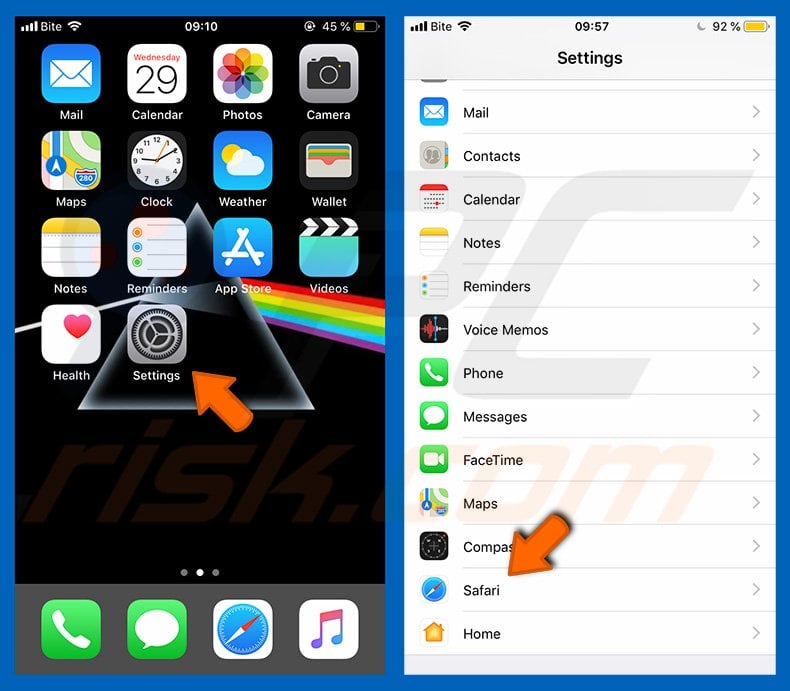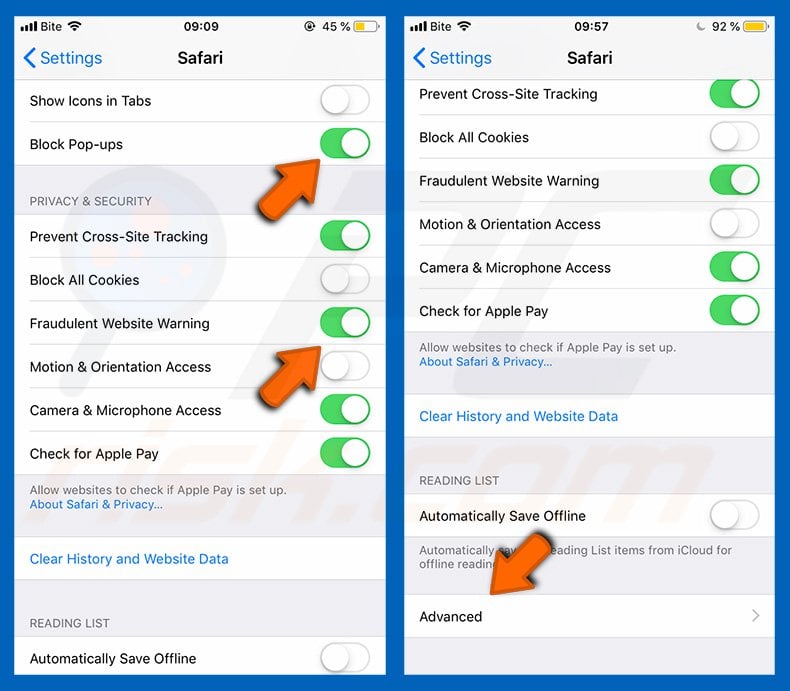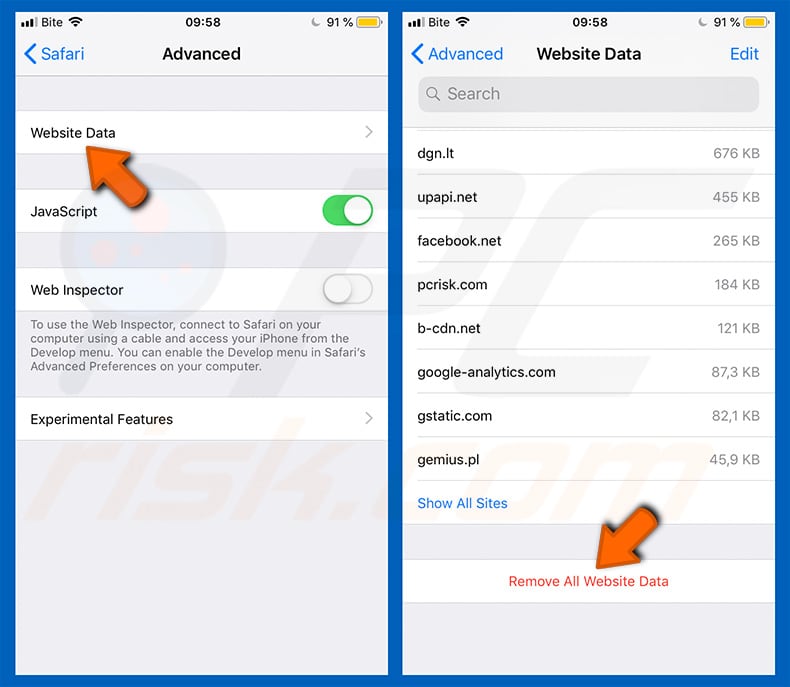Get free scan and check if your device is infected.
Remove it nowTo use full-featured product, you have to purchase a license for Combo Cleaner. Seven days free trial available. Combo Cleaner is owned and operated by RCS LT, the parent company of PCRisk.com.
What is ivpnconfig[.]com?
ivpnconfig[.]com is a deceptive website that often tricks visitors into downloading and installing a potentially unwanted application (PUA). For example, a fake anti-virus tool, adware, or browser hijacker. In most cases, these sites are opened through other dubious websites, untrusted advertisements, or by installed PUAs.
In any case, people do not often visit addresses such as ivpnconfig[.]com intentionally.
![ivpnconfig[.]com scam](/images/stories/screenshots202007/ivpnconfig-com-pop-up-scam-main.jpg)
At the time of research, ivpnconfig[.]com displayed a notification claiming that the iPhone has been hacked and someone is tracking it. The main purpose of this website is to trick the visitor into believing that her/his iPhone can be protected with an application called Secnet VPN.
The notification displayed by ivpnconfig[.]com states that the aforementioned application should be installed and launched within two minutes, otherwise a hacker will reveal the visitor's identity and send photos made with the front camera and browsing history to all her/his contacts. In most cases, pages such as ivpnconfig[.]com claim that the device is hacked, infected with viruses, etc., and encourage visitors to solve the problem with potentially unwanted applications.
In any case, websites such as ivpnconfig[.]com should never be trusted - software should be downloaded only from official, legitimate pages. As mentioned, browsers often open addresses such as ivpnconfig[.]com when PUAs are already installed on them.
Note that PUAs are often designed to open dubious websites and display advertisements. They usually display ads in the form of coupons, pop-ups, surveys, banners and others. Generally, these ads lead to dubious, potentially malicious pages or execute scripts designed to download and/or install PUAs.
PUAs often track and record information such as, for example, IP addresses, entered search queries, geolocations, addresses of visited websites, and other browsing-related details. PUAs might also record personal, sensitive data, which is sold to third parties (potentially, cyber criminals) who would misuse it to generate revenue in other ways.
These actions can cause problems relating to privacy and browsing safety. It is possible that users might also become victims of identity theft. Therefore, remove all PUAs from browsers and computers immediately.
| Name | ivpnconfig.com pop-up |
| Threat Type | Phishing, Scam, Mac malware, Mac virus. |
| Fake Claim | This page claims that the visitor's phone is hacked and a hacker is tracking it. |
| Serving IP Address | 104.27.177.47 |
| Promoted Unwanted Application | Secnet VPN |
| Symptoms | Your Mac becomes slower than normal, you see unwanted pop-up ads, you are redirected to dubious websites. |
| Distribution methods | Deceptive pop-up ads, free software installers (bundling), fake Flash Player installers, torrent file downloads. |
| Damage | Internet browser tracking (potential privacy issues), display of unwanted ads, redirects to dubious websites, loss of private information. |
| Malware Removal (Windows) |
To eliminate possible malware infections, scan your computer with legitimate antivirus software. Our security researchers recommend using Combo Cleaner. Download Combo CleanerTo use full-featured product, you have to purchase a license for Combo Cleaner. 7 days free trial available. Combo Cleaner is owned and operated by RCS LT, the parent company of PCRisk.com. |
Some examples of other deceptive websites similar to ivpnconfig[.]com are "Your iPhone Has Been Hacked", "VPN Update" and "(3) Viruses Has Been Detected". Generally, any statements in notifications displayed by such websites are bogus.
These sites display deceptive notifications stating that they have detected 'errors', the visitor's device has been hacked, infected, and so on. In any case, you are strongly advised to ignore the information given by these websites.
How did potentially unwanted applications install on my computer?
In some cases, users cause downloads and installations of PUAs by clicking deceptive advertisements that run certain scripts, however, it is more commonly caused when they download or install various programs without checking settings within the setups. Developers often distribute PUAs using a deceptive marketing method called "bundling".
They include unwanted apps into the set-ups of various programs and hide related information in "Custom", "Advanced", and other settings. Many users fail to check and change these settings, thereby allowing PUAs to infiltrate.
How to avoid installation of potentially unwanted applications
It is not safe download files or applications from unofficial, dubious pages, through Peer-to-Peer networks such as torrent clients, eMule, third party downloaders or using other channels of this kind. Also avoid third party installers. Third party downloaders and installers are often used to distribute unwanted, potentially malicious programs.
Programs and files should be downloaded from official websites and via direct links. Furthermore, check all "Custom" and "Advanced" settings and decline offers to download or install additionally-included, unwanted apps.
Do not click advertisements that appear on dubious pages (e.g., on those relating to gambling, adult dating, pornography) - they can open untrusted web pages or even cause unwanted downloads and installations. Remove all unwanted, suspicious apps (extensions, plug-ins and add-ons) that are installed on the browser immediately.
The same should be applied to software of this kind that is installed on the operating system. If your computer is already infected with PUAs, we recommend running a scan with Combo Cleaner Antivirus for Windows to automatically eliminate them.
Text in the deceptive notification displayed by ivpnconfig[.]com:
Hacker Is Tracking You!
Your iPhone connections was hacked and someone is tracking you! Do not close this page. If this problem is not resolved within two minutes, the hacked will reveal your identity and will send your browser history and frontal camera photos to ALL OF YOUR CONTACTS!
00 minute 23 seconds
How to protect your connection:
Step 1: Click Install Secnet VPN button;
Step 2: You will be redirected to AppStore;
Step 3: Install Secnet VPN, open it and tap connect button.
[Protect Connection] [Install Secnet VPN]
To enable pop-up blocking, fraudulent website warnings, and remove web browsing data in mobile Apple devices, follow these steps:
First, go to "Settings", and then scroll down to find and tap "Safari".

Check if the "Block Pop-ups" and "Fraudulent Website Warning" toggles are enabled. If not, enable them immediately. Then, scroll down and tap "Advanced".

Tap "Website Data" and then "Remove All Website Data".

Instant automatic malware removal:
Manual threat removal might be a lengthy and complicated process that requires advanced IT skills. Combo Cleaner is a professional automatic malware removal tool that is recommended to get rid of malware. Download it by clicking the button below:
DOWNLOAD Combo CleanerBy downloading any software listed on this website you agree to our Privacy Policy and Terms of Use. To use full-featured product, you have to purchase a license for Combo Cleaner. 7 days free trial available. Combo Cleaner is owned and operated by RCS LT, the parent company of PCRisk.com.
Quick menu:
- What is ivpnconfig[.]com?
- STEP 1. Remove PUA related files and folders from OSX.
- STEP 2. Remove rogue extensions from Safari.
- STEP 3. Remove rogue add-ons from Google Chrome.
- STEP 4. Remove potentially unwanted plug-ins from Mozilla Firefox.
Video showing how to remove adware and browser hijackers from a Mac computer:
Potentially unwanted applications removal:
Remove potentially unwanted applications from your "Applications" folder:

Click the Finder icon. In the Finder window, select "Applications". In the applications folder, look for "MPlayerX", "NicePlayer", or other suspicious applications and drag them to the Trash. After removing the potentially unwanted application(s) that cause online ads, scan your Mac for any remaining unwanted components.
DOWNLOAD remover for malware infections
Combo Cleaner checks if your computer is infected with malware. To use full-featured product, you have to purchase a license for Combo Cleaner. 7 days free trial available. Combo Cleaner is owned and operated by RCS LT, the parent company of PCRisk.com.
Remove adware-related files and folders

Click the Finder icon, from the menu bar. Choose Go, and click Go to Folder...
 Check for adware generated files in the /Library/LaunchAgents/ folder:
Check for adware generated files in the /Library/LaunchAgents/ folder:

In the Go to Folder... bar, type: /Library/LaunchAgents/

In the "LaunchAgents" folder, look for any recently-added suspicious files and move them to the Trash. Examples of files generated by adware - "installmac.AppRemoval.plist", "myppes.download.plist", "mykotlerino.ltvbit.plist", "kuklorest.update.plist", etc. Adware commonly installs several files with the exact same string.
 Check for adware generated files in the ~/Library/Application Support/ folder:
Check for adware generated files in the ~/Library/Application Support/ folder:

In the Go to Folder... bar, type: ~/Library/Application Support/

In the "Application Support" folder, look for any recently-added suspicious folders. For example, "MplayerX" or "NicePlayer", and move these folders to the Trash.
 Check for adware generated files in the ~/Library/LaunchAgents/ folder:
Check for adware generated files in the ~/Library/LaunchAgents/ folder:

In the Go to Folder... bar, type: ~/Library/LaunchAgents/

In the "LaunchAgents" folder, look for any recently-added suspicious files and move them to the Trash. Examples of files generated by adware - "installmac.AppRemoval.plist", "myppes.download.plist", "mykotlerino.ltvbit.plist", "kuklorest.update.plist", etc. Adware commonly installs several files with the exact same string.
 Check for adware generated files in the /Library/LaunchDaemons/ folder:
Check for adware generated files in the /Library/LaunchDaemons/ folder:

In the "Go to Folder..." bar, type: /Library/LaunchDaemons/

In the "LaunchDaemons" folder, look for recently-added suspicious files. For example "com.aoudad.net-preferences.plist", "com.myppes.net-preferences.plist", "com.kuklorest.net-preferences.plist", "com.avickUpd.plist", etc., and move them to the Trash.
 Scan your Mac with Combo Cleaner:
Scan your Mac with Combo Cleaner:
If you have followed all the steps correctly, your Mac should be clean of infections. To ensure your system is not infected, run a scan with Combo Cleaner Antivirus. Download it HERE. After downloading the file, double click combocleaner.dmg installer. In the opened window, drag and drop the Combo Cleaner icon on top of the Applications icon. Now open your launchpad and click on the Combo Cleaner icon. Wait until Combo Cleaner updates its virus definition database and click the "Start Combo Scan" button.

Combo Cleaner will scan your Mac for malware infections. If the antivirus scan displays "no threats found" - this means that you can continue with the removal guide; otherwise, it's recommended to remove any found infections before continuing.

After removing files and folders generated by the adware, continue to remove rogue extensions from your Internet browsers.
Remove malicious extensions from Internet browsers
 Remove malicious Safari extensions:
Remove malicious Safari extensions:

Open the Safari browser, from the menu bar, select "Safari" and click "Preferences...".

In the preferences window, select "Extensions" and look for any recently-installed suspicious extensions. When located, click the "Uninstall" button next to it/them. Note that you can safely uninstall all extensions from your Safari browser - none are crucial for regular browser operation.
- If you continue to have problems with browser redirects and unwanted advertisements - Reset Safari.
 Remove malicious extensions from Google Chrome:
Remove malicious extensions from Google Chrome:

Click the Chrome menu icon ![]() (at the top right corner of Google Chrome), select "More Tools" and click "Extensions". Locate all recently-installed suspicious extensions, select these entries and click "Remove".
(at the top right corner of Google Chrome), select "More Tools" and click "Extensions". Locate all recently-installed suspicious extensions, select these entries and click "Remove".

- If you continue to have problems with browser redirects and unwanted advertisements - Reset Google Chrome.
 Remove malicious extensions from Mozilla Firefox:
Remove malicious extensions from Mozilla Firefox:

Click the Firefox menu ![]() (at the top right corner of the main window) and select "Add-ons and themes". Click "Extensions", in the opened window locate all recently-installed suspicious extensions, click on the three dots and then click "Remove".
(at the top right corner of the main window) and select "Add-ons and themes". Click "Extensions", in the opened window locate all recently-installed suspicious extensions, click on the three dots and then click "Remove".

- If you continue to have problems with browser redirects and unwanted advertisements - Reset Mozilla Firefox.
Share:

Tomas Meskauskas
Expert security researcher, professional malware analyst
I am passionate about computer security and technology. I have an experience of over 10 years working in various companies related to computer technical issue solving and Internet security. I have been working as an author and editor for pcrisk.com since 2010. Follow me on Twitter and LinkedIn to stay informed about the latest online security threats.
PCrisk security portal is brought by a company RCS LT.
Joined forces of security researchers help educate computer users about the latest online security threats. More information about the company RCS LT.
Our malware removal guides are free. However, if you want to support us you can send us a donation.
DonatePCrisk security portal is brought by a company RCS LT.
Joined forces of security researchers help educate computer users about the latest online security threats. More information about the company RCS LT.
Our malware removal guides are free. However, if you want to support us you can send us a donation.
Donate
▼ Show Discussion